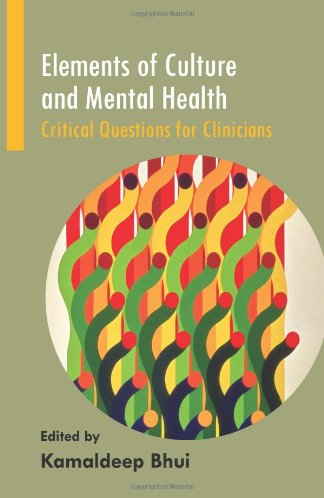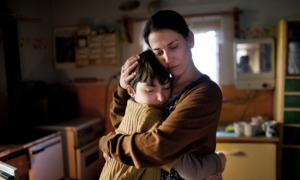 Elements of Culture and Mental Health: Critical Questions for
Elements of Culture and Mental Health: Critical Questions for
Clinicians
Kamaldeep Bhui, Editor
RCPsych Publications, 2013
106 Pages
By Gail Bush
In the fall of 2013, a conversation with an older, male, Columbian interpreter for a mostly Mexican women’s health clinic in rural mid-America highlighted the challenges of cultural differences and mental-health practitioners. The interpreter explained the difficulties regarding his vast cultural differences, age and gender, even though the language he was translating was basically the same. He had sincere compassion for the young, troubled clients who felt his role as intrusive, yet necessary, as they needed his language skills to inform the practitioners of their very personal concerns. His comments confirmed that a shared language is not a solution to cultural differences in mental health practice.
Considerations of culture in mental-health treatment takes center stage in “Elements of Culture and Mental Health: Critical Questions for Clinicians” a handbook published in 2013 by the Royal College of Psychiatrists and written by an ethnically diverse authorship. The goal of this book, writes Dr. Kamaldeep Bhui, editor, “is to offer readers a concise, thought-provoking, engaging and creative set of essays … that are central to improving the quality of care for culturally diverse populations.” He hopes mental health practitioners will be intellectually curious about issues raised and will seek discourse with colleagues to further their knowledge together. When youth workers compare notes, there are often subjects related to cultural differences that come up in conversation, and just a bit of background into relevant studies adds substance and meaning. Indeed, these 20 essays of both brevity and scholarly depth serve as quick reference points or robust springboards for discussion.
Essay topics range from the quality of practice when interpreters are involved in treatment to differences in cognitive-behavior therapy based on cultural backgrounds. Often taboo subjects such as religion and spirituality are also discussed, as they are pertinent in many cultures and may play a role in treatment.
This book studies the use of interpreters in a few of the essays that focus on two distinct types of treatment: cognitive-behavioral therapy and psychotherapy. In the first, Dr. Rathod and Dr. Naeem explore the complex role of an interpreter. Oftentimes the interpreter is a member of the community or the family. Obvious conflicts of confidentiality and interest arise in either case. Optimally, a trained and experienced interpreter is preferred — but not always available. In another essay, Dr. Tribe and Dr. Qureshi claim that all parties — the therapist, client and interpreter — might have substantive concerns. They caution that a shared language does not guarantee a shared culture and that such a generalization should not be assumed.
Reading essays that mine down into therapeutic practices might seem like time that could be directed to more practical applications for the youth worker. But even those in the service of youth who have a more heterogeneous community can employ these lessons based on culture and language by astutely approaching adolescence as its own subculture.
Bringing any third party into mental health services, whether interpreter or other type of mediator, questions remain, such as: “knowing the interpreter well, their specific subcultural group, language and attitudes to race and culture, their latent identities, and specific details and accompanying contexts of their cultural histories.” Discussions of this ilk beg the question of the practitioner knowing thyself in the service of youth.
The place that religion and spirituality have in life differ certainly from culture to culture, and even more specifically from family to family and, of course, from individual to individual. While these topics may have previously been deemed out of the realm of treatment, they are important factors to consider in trending health care practices. In a 2004 U.S. study published in the Annals of Family Medicine report that 83 percent of patients who visit family practices for their primary care needs “wanted physicians to ask about their spiritual beliefs under certain circumstances.”
“Elements of Culture” discusses recent research showing how spirituality offers a peaceful refuge that can have a positive impact on suicide prevention. As with many of the essays, Dr. Bhui ends this last entry with implications for clinical practice, suggesting a spiritual history can be a helpful tool in treatment. Further he recommends that medical students be trained to take the history and to include it in assessments. He sagely recounts that religious and spiritual practices have survived over time and might “open a door onto a new dimension in mental health care, one that we have only just begun to explore.”
“Elements of Culture and Mental Health” offers an exploration into intercultural competence for mental health care practitioners and policymakers. The best utility of this volume may follow social psychologist Kurt Lewin’s famous decree that there is nothing more practical than a good theory. While these essays do indeed read scholarly and academic, they are concise, accessible, potentially transformative and surprisingly practical upon close study. This cohesive collection offers brief insights into critically important aspects of intercultural understanding that benefit practitioners not only with the youth they serve but also with the colleagues they work along side, the learners they might teach, perhaps the communities they might inhabit, and indeed, the lives they lead.






























